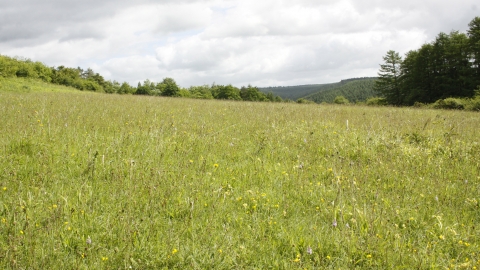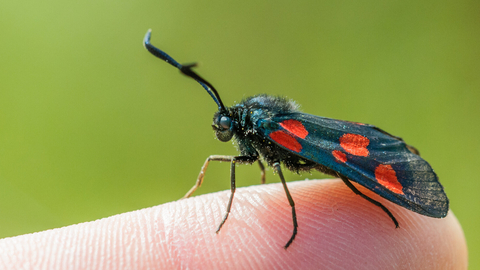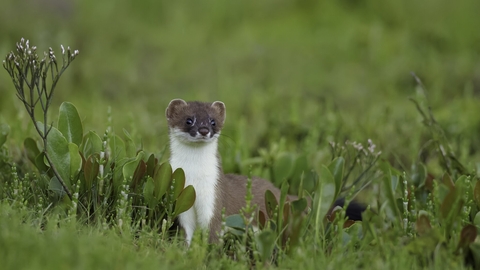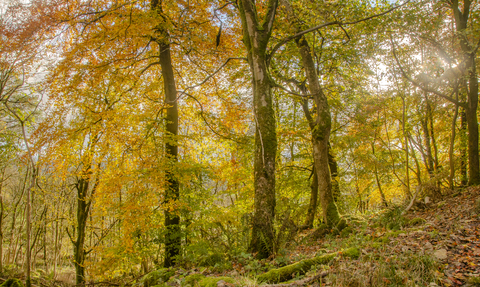

false - Lee Myers
Instagram credit is @lee_myers_mido2k2

Stoat (Mustela erminea), standing amongst saltmarsh plants, Conwy, June 2012, - Richard Steel/2020VISION
Ellerburn Bank Nature Reserve
Location
Know before you go
Dogs
When to visit
Opening times
Open at all times. We recommend a 1 hour visit to this reserve or explore more of Dalby Forest for a longer visit.Best time to visit
March to SeptemberAbout the reserve
The sun is out, and so are the vibrantly coloured meadow flowers – several species of orchid, rock-rose, cowslip and quaking grass. Bright orange small copper and small skipper butterflies, and black-and-red, day-flying six-spot burnet moths flutter between them. Adders bask by the drystone walls, and stoats cavort around the flower stems. Willow tits are occasionally seen, while willow warblers and yellowhammers sing from coppiced scrub and trees around the site. Keep a close eye on the sky, as goshawks are regularly seen in the area, and common buzzards nest nearby.
Habitat
Contact us
Environmental designation
About
This excellent example of limestone grassland has never been farmed or worked in any way. Its thin, free draining soils support species such as rock-rose, cowslip and quaking grass. A few rarities can also be found here including some orchid species.
The meadows are generally at their most picturesque in June and July, an impressive sight for such a small nature reserve. Rabbits, foxes, badgers and roe deer are frequent visitors that leave telltale signs, whilst stoats can be seen whisking through the stems during the day. Adders are seen occasionally around the drystone wall. Butterflies breeding here include small copper and small skipper.
The field contains small amounts of hawthorn and gorse scrub and is bounded by woodland on two sides. The bushes and trees surrounding the site host willow warblers, bullfinches and yellowhammers. Buzzards breeds nearby and there is always the chance of an overflying goshawk or crossbill.
Situated on the shoulder of Pexton Moor the nature reserve slopes down into the valley towards Dalby Beck. Along the western edge of the site is an ancient earthwork that is thought to be a late Bronze Age double bank and ditch. This is a scheduled ancient monument on which management is limited.
Winter grazing using Hebridean sheep keeps young scrub in check and the sward healthy, allowing it to flower and seed throughout the summer. The patches of scrub that do not get grazed sufficiently by the sheep are mechanically managed to prevent spread into the pasture. The northern boundary is drystone wall and is maintained by Trust staff and contractors. Hedges are kept in good condition by ‘gapping up’ with mixed tree saplings that are protected by guards.
Seasonal highlights
- Spring: Plants - Cowslip; Invertebrates - Brimstone; Reptile - Adder; Birds - Willow warbler
- Summer: Plants - Fly orchid; Quaking grass; Invertebrates - Small skipper; Small copper
- Autumn: Birds - Buzzard; Crossbill
- Winter: Mammals - Stoat; Birds - Yellowhammer
Directions
Public transport
Regular bus services into Thornton Dale. Nearest train station is in Malton.
By car
From Thornton-le-Dale take the Whitby road for 11/2 miles and then turn right into Forest Drive. Two tracks lead to the site. The first passes a sawmill and the second is just past the entrance gate to Forest Drive. There is no parking by the entrance to the sawmill and there is an admission charge to enter Forest Drive.
Great place to walk and enjoy the great outdoors.Google Reviews

The autumn colours were even more beautiful when the sun came out
Photo Credit - Telling our Story Volunteer, Sara



